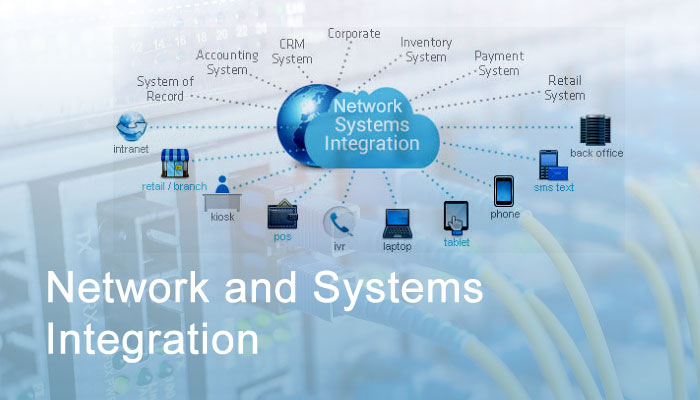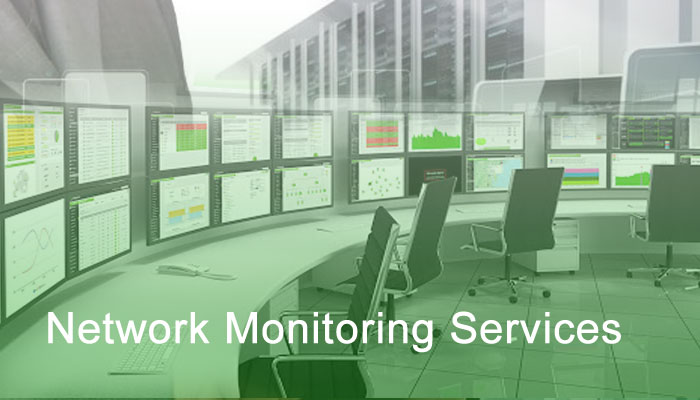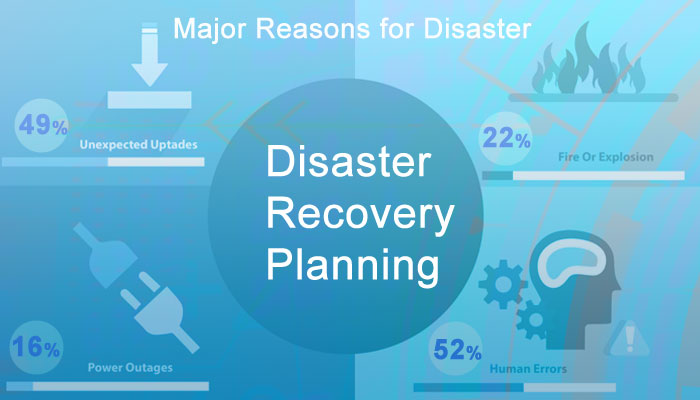Disaster Recovery Planning
Disaster Recovery Planning
The technology age is prominently marked with innovations in every sphere of business and life with the aid of incessant advancements in technology. The traditional world has given way to a complete cyber domain where the Internet or Wide Area Networks (WANs) play a key role. Most businesses rely on technology and automated systems to a great extent to efficiently continue business operations. Disruptions caused due to any type of technological snag might cause severe loss in finance and productivity. In order to avert such disruptions and enable continuity in operations, an organization needs to plan meticulously through analyzing potential disasters, developing a workable Disaster Recovery plan to reduce the disruptions of critical functions, and the capacity to expedite the recovery process. A Disaster Recovery Plan (DRP), (AKA Business Continuity Plan (BCP) or Business Process Contingency Plan (BPCP)) is an effective executable plan that delineates the way an organization would deal with potential disasters.
Disaster Recovery Planning (DRP) is the process that gives a comprehensive plan on the steps that are necessary to restore business operations immediately following a disaster or disruptions. A Disaster Recovery Plan is the statement of logical actions, which are to be taken prior to and after a natural or man-made disaster. The prime objective of Disaster Recovery and Planning is to minimize the impact that calamities are likely to cause on businesses and to protect the organization from similar events in the future. The Planning process is the key to ensuring organizational stability and complete recovery after a disastrous event. Preparedness will greatly help reduce the possibility of risks. The Disaster Recovery Plans should be well documented and tested beforehand in order to ensure there is no disruption in work conditions. Critical resources essential for mission critical operations carried out by organizations should be made available through efficient Disaster Recovery and Planning.
In Disaster Recovery Planning, there are certain phases in the process that enable to shape up an effective Disaster Recovery Plan. They are explained below:
1. Planning and Coordination Team
A team comprising representatives from all departments of an organization along with a head from the management must be formed to supervise the structuring of the plan and the implementation of the same. Resources and time should be set apart for developing the plan. This team will be responsible for determining recovery strategies, data collection, organizing efforts, documenting, and testing and approving the DRP.
2. Assessment of Risks
A thorough analysis of the risks and its impact on business in the event of natural or human-induced disasters should be made. The various disaster scenarios that bring up potential risks and consequences are to be closely assessed. Most importantly, the process should consider safety measures to be taken to protect critical documents and records. Vital records should be categorized by priority and the necessary procedures outlined. The amount of time required for each activity in restoration operations and processing in Business Disaster Recovery must be clearly documented.
3. Defining Disaster Recovery Strategies
This is a very important phase in disaster recovery and planning. In defining the recovery strategies, the following aspects need to be considered to formulate a plan that covers the entire scope of the organization: Hardware and Software, Communications, Data, User and processing operations, customer services, end-user systems, and other related operations. These aspects will aid in developing an appropriate Disaster Recovery Plan.
4. Data Collection
Gathering data is crucial for developing an efficient Disaster Recovery Plan. Data collection involves meticulous research and documentation. Information including important contact numbers, backup and retention schedules for software and data files, all types of inventory, Master call/vendor/customer list, temporary location specifications, and other documentation.
5. Documentation
The plan once developed should be documented in details and in a standard format. An outline of the plan can be made prior to drafting the original detailed plan. Organizing and documenting a written plan ensures that the Disaster Recovery Plan is followed precisely in the event of a disaster. Detailed procedures help in effecting the DRP during emergency times and also maintaining and updating the procedures for future use. The documented should be subjected to constant review and add-ons wherever necessary.
6. Testing
In order to determine the feasibility of the plan, it should be tested and evaluated at frequent intervals. Executing the plan on a test basis will enable to judge accurately the effectiveness of the Disaster Recovery Plan that has been developed. It will help to make necessary inclusions and revisions in procedures, and remove unnecessary steps. Common testing procedures include Checklist tests, Simulation tests, Parallel tests, and Full interruption tests. The plan is normally tested in sections and after working hours so as to avert causing disruptions to an organization's overall operations.
7. Approval and Evaluation
The documented and tested Disaster Recovery Plan is submitted for approval to the core management team. The DRP is reviewed by the team and then approved. This core team, which gives the plan approval, is responsible for establishing policies and procedures. It also has to annually review and approve the Disaster Recovery Plan or Business Contingency Plan, and document those reviews.
A well-designed Disaster Recovery Plan takes into consideration the requisites and of a particular organization and analyzes the potential risks it might face with the IT infrastructure it is built upon. Disaster Recovery Planning allows for numerous advantages by taking into consideration many aspects of business. Key benefits include:
- Ability to sustain/continue operations
- Protecting organization repute and brand image
- Mitigating disruptions caused by calamity and reducing downtime
- Maintaining customer integrity even in temporary disruptions
- Stepping up confidence levels of clients, investors, partners, and associates
FatPipe has an unique Disaster Recovery process which an organization uses to recover access to their software, data, and/or hardware that are needed to resume the performance of normal, critical business functions after the event of either a natural disaster or a disaster caused by humans.
Disaster Recovery Plans are generally part of a larger, more extensive practice known as Business Continuity Planning. Disaster Recovery plans should be well practiced so that the key players are familiar with the specific actions they will need to take should a disaster occur. Disaster Recovery plans must also be adaptable and routinely updated, e.g. if new people, a new branch office, or new hardware or software are added to an organization they should promptly be incorporated into the organization's disaster recovery plan. Companies must consider all these facets of their organization as well as update and practice their plan if they want to maximize their recovery after a disaster.
Networking Services

WAN Management and Security
FatPipe Technology (a wholly owned subsidiary of FatPipe Networks Ltd) is a world leader in providing WAN redundancy solutions using state of the art technology..

Network and Systems Integration
FatPipe Technologies is leading provider of integrated solutions to design, upgrade and expansion of any business. Our solutions consolidate and optimize IT resources..

Network Monitoring Services
FatPipe Network Monitor is a unique addition to the FatPipe family of products. Network Monitor is a solution for management of network devices, such as routers, switches..

Disaster Recovery Planning
The technology age is prominently marked with innovations in every sphere of business and life with the aid of incessant advancements in technology..
Upon receipt of the completed form below we will promptly review your requirements and respond with a comprehensive quote taylored to your specific solution.
Uploading your resume, you'll automatically be considered for jobs that match your skills and experience.